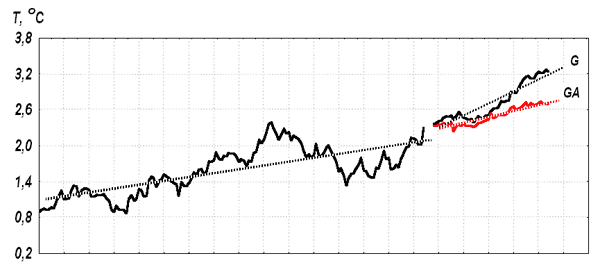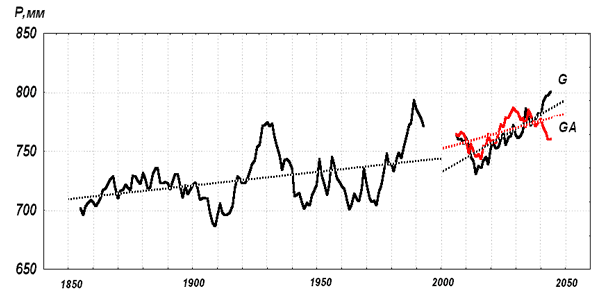
Possible changes of climate and water balance parameters for the period 2000-2050
The estimation of climate changes for the territory of North-West of Russia (NWR) was made using ECHAM-4 model data in accordance to the G- and GA-scenarios, respectively. The estimation of these data shows that a general tendency to increase of annual air temperature and precipitation will remain in the new climate for both studied regions (Fig. 15). Mean annual precipitation will increase about 30-50 mm for both scenarios. Mean average annual air temperature for the next 50-years period will rise from 1.8 up to 2.5-2.7 °C.


Fig. 15. Observed (up to 2000) and modeled for G-scenario and GA-scenario (broken line) time series of air temperature and precipitation for the territory of North-West of Russia. All values are 15-year moving averages.
For the territory of North-West of Russia, where a regional water balance simple statistical model was designed, the general tendencies of basic water balance elements for the future climate were estimated. Thereto the simulated data on annual air temperature and precipitation, obtained by ECHAM-4 model for both scenarios, were put into the regional model. It is important to note that preliminary 15-year moving smoothing of model data is necessary for correct calculation due to the regional water balance model was designed only for 15-year moving values of water balance elements. Using this coupling, it gives a possibility to estimate possible changes in the precipitation, total evaporation and river runoff for the territory of North-West of Russia in the 2000-2050 period. This estimation shows that for both the G- and GA-scenarios all water balance parameters, excluding river runoff, will increase (Table 2). It is in good correspondence with model data obtained by other GCMs (Golitsyn et al. 2000; Busarova & Gusev 1995). In Karelia during the next 50-year period total evaporation will increase by 10-13 %, as well as precipitation will increase only by 1-2 % for both scenarios. As a result, river runoff determined as a deviation between precipitation and total evaporation R=P-E will slightly decrease, from the modern mean average annual value of 322 mm down to 312-297 mm. As it was shown above, at present the spring air temperature over the territory has a most marked positive trend. In future, in accordance with G- and GA-scenarios the winter season (December-February) would have the largest rise throughout all the area. Future climate conditions in NWR become warmer for the summer and winter months, and, in opposite, there will not be noticeable changes in air temperature during spring and autumn.
Table 2.
Possible changes of mean annual air temperature and water balance elements in NWR at the first half of 21th century
|
Element |
Period |
Scenario |
Changes, per cent |
|
|
1950-1999 |
2000-2049 |
|||
|
Air temperature, îÑ |
1,8± 0,2 |
2,7± 0,3 2,5± 0,1 |
G GA |
|
|
Precipitation, mm |
750± 25 |
763± 17 767± 12 |
G GA |
|
|
Evaporation, mm |
413± 13 |
466± 17 455± 9 |
G GA |
|
|
River runoff, mm |
322± 14 |
297± 7 312± 7 |
G GA |
|
Conclusions
In climatological and water balance data time series for the 1880-1999 period the noticable increase of annual air temperature in eastern Fennoscandia including Karelia was detected. For the second half of the last century (1950-1999) linear trends in annual air temperature are characterized by positive values and equal to 0.60 °C/50 years for North-West of Russia. Also in the annual precipitation time series, the positive tendencies were detected, about 78 mm/50 years. Our results demonstrate that characteristics of the fluctuations recorded in climatic parameters were caused mainly by natural climate fluctuations. It is complicated to determine factors responsible for the natural and anthropogenic depositions to climate changes in the region.
It is important to note that total river runoff in NWR in 2000-2050 may decrease from 322 mm now to 297-312 mm. At present, the highest positive trends are marked for the spring seasons over the studied area, whereas in the future for the both scenarios the winter seasons (December-February) will have the highest positive trends. In accordance with model data, the noticeable changes in distribution of monthly air temperature may become possible: in spring-autumn (May-October) it will be warmer than at present. For both scenarios the basic climatic and hydrological elements of the studied area will change, but as it follows from analysis that was made, with no disastrous effects in the next 50-year period. The climate in Karelia as well as in NWR will become more maritime, and in northern areas more continental. It is possible to assume that in NWR during the period 2000-2050 slow changes in the ecosystems may start, including those in water ecosystems. As the air temperature increases, the water temperature in lakes will also increase, the ice-free period will last from seven to nine months, and the atmospheric precipitation will increase. This may result in an increase of water level in the lakes of this region. As these processes develop, the eutrophication of the basin will grow.

Fig. 17. Observed (up to 1999) and model for G-scenario and GA-scenario (broken line) time series of water balance elements for the territory of North-West of Russia. All values are 15-years moving averages.
Shortening of the ice period in the water bodies will promote the rising of water temperature, more intensive mixing of water masses in the lakes, decreasing of the hypolimnion layer and, as a result, a shortage of dissolved oxygen in the lake waters. Under this development, the serious changes of the hydrodynamic regime of the largest lakes of Europe are possible, and those will affect the rate of euthrophication processes. Under increase of air temperature by 1°C, the productivity of coniferous forests in the NWR region will rise by 0.3-0.4 bonus class. At the present volume level of fells (6-10 mill. m3 per year), it will not cause noticeable changes in the water balance of the region. During the last decades of the 20th century, noticeable changes in biodiversity and in the structure of the biotic component of ecosystems of the European North of Russia are remarkable. Qualitatively, different biotopes not previously typical before have occurred in the natural zones of the European North.
Acknowledgements
This study was partly funded by the INTAS, grants 97-1277 "Detection and Modeling of Greenhouse Warming in the Arctic and sub-Arctic" and INFO-00-614 “Development of an information access system for high latitude climate data, analysis and numerical simulations of climate change - Climate Data Access System (CLIMAS)”.
References can be found here.